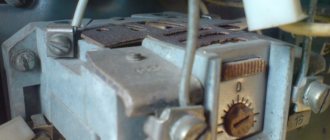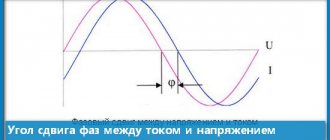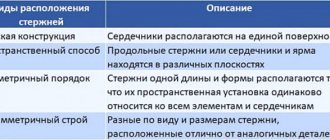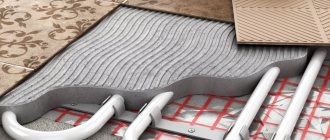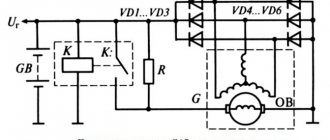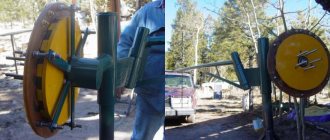All known types of generating devices, according to the characteristics of their operation, are divided into synchronous and asynchronous machines, and it is the latter type that is most widespread. Their design and principle of operation are similar to asynchronous motors, but energy conversion in the generator occurs in the opposite direction (from mechanical to electrical). You can see what an asynchronous generator looks like in real life in the figure below.
Asynchronous generator (AG)
Similar to asynchronous motors turned on in reverse mode (for braking), when generating energy, approximately the same effect is observed, leading to its partial dissipation in the form of heat. It follows from this that the efficiency of such a device is relatively low.
Principle of operation
A preliminary acquaintance with the basics of the functioning of synchronous-type generator machines will help you to understand well the principle of operation of an asynchronous mechanism. The fact is that synchronous and asynchronous generators are very similar in their design and method of operation and differ only in small details (the design of the rotating rotor, in particular).
The first class mechanisms use a rotor with permanent magnets placed on it. When it rotates from a mechanical drive, magnetic elements induce an electromagnetic field in the stator that varies in magnitude and direction, ensuring the flow of alternating current in the load connected to its terminals. In this case, the rotor itself rotates without mismatch with the EMF it creates in the coils (in phase with it).
Unlike synchronous machines, an asynchronous generator is characterized by the presence of a slight lag in the rotation of the rotor element of the device in relation to the electromagnetic field induced in the stator. The latter seems to slow down its movement, which is commonly called the “sliding effect.”
Note! This phenomenon is explained by the design feature of the AG rotor, manufactured in the form of a short-circuited solid lattice (the so-called “squirrel wheel”). Its appearance is shown in the photo below.
Squirrel wheel rotor
When the drive shaft rotates under the influence of an external mechanical impulse (from an internal combustion engine, for example), due to the residual magnetism of the stator, its own EMF is induced in the grid of such a rotor. As a result, both fields (moving and stationary) begin to interact with each other in a dynamic mode.
Since the field in the rotor windings is induced with a delay relative to the stationary stator of the generator, it lags somewhat behind the e/m field induced in it (that is, it rotates asynchronously).
Engine conversion
The principle of converting a motor into a simple asynchronous generator:
- To upgrade, you will need a motor from a washing machine.
- Reduce the thickness of the core walls. To do this, you need to turn 2 mm over the entire surface on a lathe. Make holes (non-through) no more than 5mm deep.
- Make a strip from a thin sheet of metal or tin, the dimensions corresponding to the dimensions of the rotor.
- Install neodymium magnets in the resulting free area in an amount of at least 8 pieces. Secure with superglue.
The magnets must be pressed against the surface until they harden completely, otherwise they will move. It is recommended to use glasses to prevent glue from getting into your eyes if the magnet slips out.
- Cover the rotor on all sides with thick paper and secure the edges with tape.
- Effectively seal the end part of the rotor with mastic.
- Fill the free space between the magnetic elements with epoxy resin through the hole made in the paper.
- After the resin has hardened, remove the layer of paper.
- Sand the surface of the rotor with sandpaper; if available, you can use a Dremel.
- Connect the motor to the working winding with two wires. Remove all unused wires.
- If necessary, replace the bearings with new ones.
- Install the current rectifier and charging controller.
Testing the assembled device
Possibility of control
New power generators
Another feature of a synchronous generator (as well as an asynchronous one) is that the frequency and amplitude of the EMF induced at the stator terminals significantly depends on the rotor rotation speed.
Important! As the active load connected to the generator changes, the frequency of rotation of the generator shaft also changes in proportion to it, which leads to a change in the characteristics of the EMF created in the stator.
This drawback forces the installation of an electronic voltage and frequency regulator in synchronous and asynchronous devices, which ensures that these parameters are maintained at the proper level (the regulator diagram is given below).
AG voltage regulator circuit
Since the asynchronous generator operates on the principle of mismatched rotation of the fields of the moving and stationary parts, it is not possible to regulate the output parameters within the system. This is explained by the impossibility of organizing instantaneous voltage feedback by supplying part of the output signal from the stator to the rotor (only external voltage stabilizers can be used in AG).
This is another difference between asynchronous units and their synchronous counterparts, which in all other characteristics are very similar to the former.
Low-power generators 220 V
Asynchronous electric motors with squirrel-cage rotors from washing machines, household vacuum cleaners, electrical watering appliances and similar ones, in which capacitor batteries are connected in parallel to the working winding, are used as donor devices. To increase operating efficiency, the capacitor capacity is increased: to a lesser extent for active loads (lamps, soldering irons), and to a greater extent for inductive loads (for example, refrigerators, TVs, etc.).
Alternator
Primary mechanical mover (recommendations):
- The power of the primary device is selected to be 50..100% greater than the power consumed by the asynchronous generator. This is necessary to reduce losses and increase process efficiency. Increased efficiency is achieved by permanently or briefly increasing the speed of a mechanical element.
- Since the circuit does not contain a current regulator, stable operation of the installation requires constant monitoring of the parameters, i.e. the presence of a device for measuring frequency (tachometer), voltage (voltmeter) and a set of switches (for connecting the load to the generator, and two for switching the excitation circuit. This circuit simplifies the start-up and increases the stability of the electrical equipment.
- If a household lighting network is connected to the generator, it is necessary to provide a two-phase switch in the electrical circuit, which in this case will disconnect the electric lighting from the stationary network.
Single-phase switches for disconnecting are prohibited in this case, because it is necessary to disconnect the phase and neutral wires.
Benefits and Applications
The advantages of asynchronous generators include the following properties:
- AGs are resistant to overloads and short circuits, and also have a relatively simple design (this distinguishes them from more complex synchronous machines);
- The indicator of nonlinear distortion of a sinusoid does not exceed 2 percent (compare 15% for their synchronous analogues);
- Due to the low clear factor value, asynchronous devices guarantee high stability of the operation of the UPS and TV receivers connected to them;
- When powering welding equipment, they provide a significant improvement in welding quality;
- To stabilize the output voltage, they can use external automatic control devices;
- When rotating, AG rotors generate a limited amount of heat, which does not require powerful fan devices to compensate.
Metal corrugation for wiring
The latter property allows you to reliably seal the internal cavity of the unit, that is, protect it from the penetration of dust and dirt. Thanks to this circumstance, the scope of application of asynchronous machines capable of operating in conditions of great dust and high humidity is significantly expanding.
The possibility of sealing contributes to the fact that asynchronous type electric generators have a longer service life and can be operated at low temperatures. Let's add to this that it is allowed to connect loads of varying power to each of the phase windings of these units.
Additional Information. The permissible rate of unevenness of phase loads (the difference in the currents they consume) is about 70% for AG, which cannot be achieved when working with synchronous units.
A disadvantage that can be easily eliminated during operation is the rather “heavy” starting characteristics of the generator, which can be corrected by installing special starting amplifiers (figure below).
Starting generator circuit
These devices provide the ability to smoothly bring the generator into operating mode even with significant starting currents.
In all other respects, AGs have undeniable advantages over synchronous machines, some of the differences with which were discussed earlier. Due to these advantages, they are widely used as sources of electricity in the following economic areas:
- For power supply to equipment with rheostatic or regenerative braking mode (cranes, conveyors, etc.);
- In industrial equipment that does not require compensation for parasitic reactive power and does not have high requirements for the quality of supplied energy;
- In domestic and field conditions, where sources of cheap electricity with mechanical drive from a diesel engine are required;
- As a powerful charger that recharges batteries in car repair shops, for example.
In addition, they can be used as power sources to which welding units are connected, as well as to ensure uninterrupted power supply for critical healthcare facilities.
Installation efficiency
How to check the generator
Before carrying out reconstruction, it is necessary to take into account the scale of the economic effect of the new equipment and the feasibility of the procedure.
Device advantages:
- Low cost of electricity: conversion requires the presence of a magnetic field that generates an electric current.
- The current contains a small number of higher harmonics: small losses due to its own heating, the formation of magnetic fields, etc.
- High reliability.
- No excitation circuit.
- Cheapness of ready-made models.
- Possibility of converting a simple asynchronous motor into a generator.
- The absence of a commutator-brush mechanism in the device design, which increases the service life.
- No need for maintenance of capacitor banks.
Flaws:
- Inability to generate industrial frequency of the generated current.
- There is no network parameter control.
- The need to include rectifiers in the operating circuit.
- An inductive load requires an increase in the applied capacitance requirement. Consequently, the need to connect additional capacitor elements to the device circuit increases. Which subsequently increases the cost of installation.
- The device is no less technically complex than synchronous generators.
- High sensitivity to load changes. Because To operate the device, a capacitor is used, which takes energy (traditional generators use batteries that have a power reserve); if the load increases, there may not be enough electricity for recharging and generation will stop. To prevent this phenomenon, batteries with variable capacity depending on the load are used. The use of this equipment is economically feasible for large facilities.
Types of asynchronous machines
The electricity meter is broken: what to do?
Different types of AG may differ in the following performance characteristics:
- The type of rotating part of the generating device - its rotor;
- The number of output or stator windings in the generator (the number of operating phases);
- The connection diagram of the three-phase generator coils - triangle or star, as well as the method of their placement and laying on the stator poles (photo below);
Placement of stator windings
- The presence or absence of a separate excitation winding.
In accordance with the first of these characteristics, all known types of AG are equipped with a squirrel-cage or phase-wound rotor. The first of them is made in the form of a one-piece cylindrical structure, consisting of individual pins with two rings closing them (of the “squirrel wheel” type).
The phase rotor, unlike its squirrel-cage counterpart, has an inductive winding made of insulated wire, which ensures the creation of a dynamic electromagnetic field. Due to the peculiarities of its design, such a rotor has a high manufacturing cost and requires specialized maintenance.
The output windings of the stator, like the entire generator, can be single-phase or three-phase, which is determined by the direct purpose of this unit (when a voltage source of 220 or 380 Volts is required). Regarding the first of these designs, everything is quite clear, but the three-phase modification of the AG has one more feature regarding the electrical circuit for switching on the windings.
It is known that to form any three-phase power supply network in electrical engineering, two types of connection of windings are used, shifted in vector representation one relative to the other by 120 degrees. This:
- Star switching, when the beginnings of the coils are connected at one point, where a zero wire is formed, and their ends diverge along three power lines (together with the neutral wire, there are four of them, as shown in the photo below);
4-wire star connection
- A “triangle” connection, in which the end of one coil is connected to the beginning of the second, and so on until the chain is completely closed. The second connection option is used in 3-wire power supply lines, since there is no neutral wire in this circuit.
In each AG product, the connection according to one scheme or another is implemented in very specific ways, allowing the wires of all stator windings to be placed between the poles of its core. They are wound in such a way that each section of phase coils A, B and C is offset along the circumference from each other by exactly 120 degrees.
In conclusion of the review of generator devices, let us pay attention to the possibility of manufacturing an AG from an asynchronous motor. Such a prospect appears thanks to the well-known principle of reversibility of the action of electric machines, according to which the direction of energy conversion can be chosen arbitrarily.
